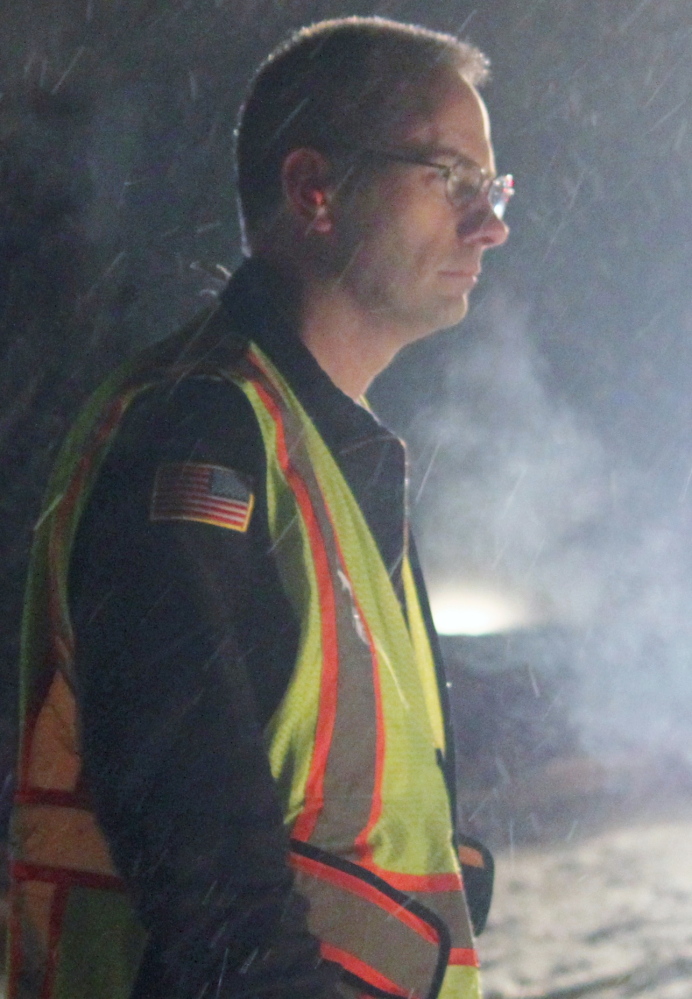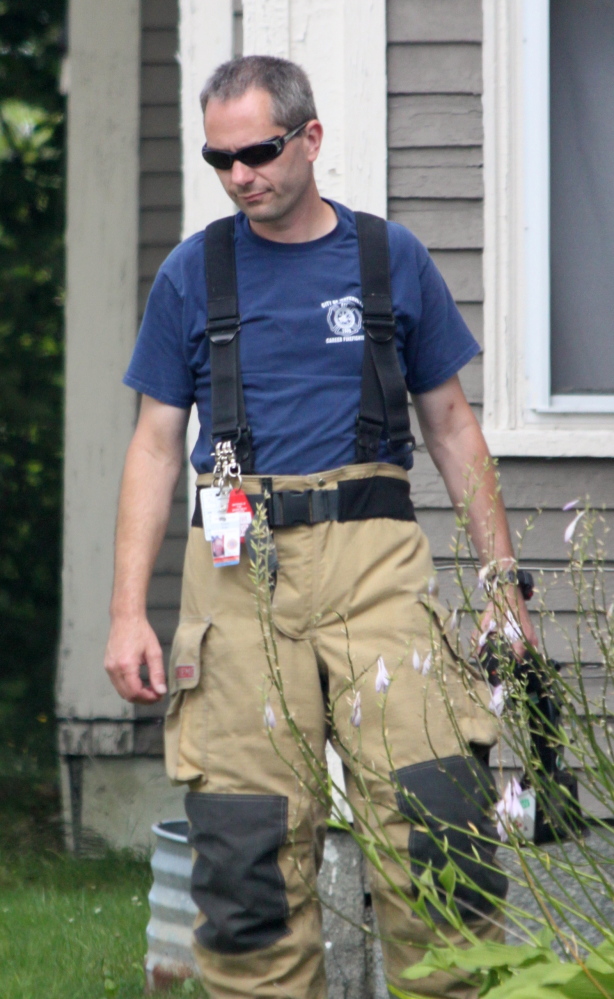By AMY CALDER
Waterville firefighter Allen Nygren has covered many motor vehicle accidents during his long career, but nothing like what he dealt with Wednesday in the massive pileup on Interstate 95 between Etna and Carmel.
Nygren, 47, was driving home to Hampden Wednesday morning after working a 24-hour shift at the Waterville Fire Department when the accident occurred.
He found himself performing triage at the scene, stepping from one slippery, snowy vehicle roof to another, checking on victims and determining who needed medical attention first.
As he helped the injured, he came upon a woman in trauma, a man with two young daughters in the car who appeared to be having a heart attack and a man in a car that was crushed under the front of a school bus, leaving just enough space in the car to save the man’s life — and he seemed to be uninjured.
“He said, ‘I’m fine, but I can’t get out,'” Nygren said. “I said, ‘OK, we’ll get to you as soon as we can.'”
Nygren said it was unbelievable that the driver of the car under the bus hadn’t died.
“I kept telling him, ‘Boy, am I glad to see you.’ I was so glad he was OK.”
As Nygren checked cars and trucks for victims, he didn’t know what he would find inside the next car. “I went from one vehicle to the next to the next, brushing snow off, hoping I wouldn’t see anything that was horrible.”
There were no fatalities in Wednesday’s chain-reaction crash, which state police said is one of the worst in the state’s history. Some 17 people were injured, but most of those were not serious.
“God’s hand was on everybody,” Nygren said.
Nygren relied on his instincts and training, using the skills he acquired as a longtime firefighter, EMT and safety instructor.
“I had no medical gear,” he said. “I had on a job shirt, which is a light sweater. I had no gloves. You’d think I’d be prepared, but I’m not prepared.”
The vehicles were so close together there was no room to walk between them.
“I had to watch out and make sure to look for gasoline leaks, fires and try to find out if there were immediate, life-threatening situations,” he said. “I came to a multiple trauma victim. I think she was pregnant. She was really hurting. She was saying she was having an anxiety attack and understandably so.
“People saw I was out there, and several started to gather. They went over and started to comfort her. Her van was heavily damaged. She was stable, breathing. I immediately determined she was the first transport. That was number one priority.”
He checked more vehicles.
“Imagine standing on a windshield of a car with snow on it. I got to one vehicle where a woman appeared compromised but not severe. When I got to her she said, ‘I have chest pain.'”
He asked about her cardiac history, and the woman said she had cardiac issues in the past and had taken some baby aspirin.
“That told me this was a heart attack,” he said. “She now became patient number one and the stable trauma became number two. I called 911. I had no radio. I tried to inform them I had 20 people injured, 40 vehicles, and I requested seven ambulances. I don’t know how many showed up. At any rate, after I got done going to the vehicles, I had to go back and do the circle again and check on the same people. That’s what I continued doing, was going back from patient to patient to patient.”
By then, uninjured accident victims had started leaving their vehicles to help others who had been hurt, he said.
“People were giving me first aid kits. A person in a white pickup truck saw I didn’t have any gloves and he gave me some gloves. That helped me so much. I’ve still got them. Someone 20 cars back made their way to the woman who was pregnant and covered her with a blanket.”
‘I REALIZED THIS WAS BIG’
Nygren’s Wednesday morning had started as usual, leaving the Waterville Fire Department around 7 a.m., entering I-95 at exit 130 and driving north to Hampden in his four-wheel drive pickup truck.
Snow was still blowing from a sudden snowburst and visibility was poor, but Nygren wasn’t worried because his truck travels well in snow.
As he drove frrom Etna to Carmel, in the distance, at the top of a hill, he saw brake lights that stayed on longer than usual.
“I put my four-way flashers on and tapped my brakes to alert traffic in back of me,” he said. “As I approached the crest of the hill, I saw an accident in front of me and blue lights. It looked like an accident in the passing lane and the driving lane was OK. It probably happened 30 seconds to a minute ahead of me.”
Nygren pulled over into the lane the accident was in and he then saw not just one car, but two.
“Then it turned into 20. At this point, I realized this is big. This is a big accident.”
Nygren parked his truck off the road as far as he could and ran to where the accident began.
“I talked to a state trooper and told him, ‘My name is Allen Nygren, I work for Waterville Fire Department and I’m an EMT.’ I said, ‘I’ll start triage.’ He knew me because he’d been in my class,” Nygren said. “He recognized me, but I didn’t recognize him.”
A firefighter since 1989, Nygren has worked for Waterville Fire for six years and owns a business, Training Technologies, teaching safety classes about firefighting, how to handle chemical spills and how to rescue people. He teaches at the Maine Criminal Justice Academy in Vassalboro, at paper and power companies and for military and transportation groups.
At the crash Wednesday, he saw a woman in trauma who had moderate to serious facial injuries, many people who were trapped in their vehicles but who did not need immediate medical attention, and the one school bus in the accident from Regional School Unit 19 of Newport.
The bus was carrying two special needs students, an aide and the driver and was on its way to a program in Old Town.
There was a first aid kit in the bus, and Nygren gave it to one of the students.
“It helped that little boy not feel scared, just because he had a Band-Aid,” Nygren said. “People were comforting each other and helping people out of their vehicles and giving them blankets and first aid kits and said, ‘Come and sit in my car where it’s warm.'”
As victims began to be treated by the first ambulances to arrive, many more emergency units were arriving, he said. Fire officials from Etna, Carmel, Plymouth, Hampden and Newport brought Jaws of Life power extrication equipment and all were being used.
“Emergency responders were well organized,” Nygren said.
‘PEOPLE REACHED OUT’
Early on in Nygren’s work Wednesday, he called his wife on his cellphone to tell her it would be hours before he arrived home.
“My estimate was pretty accurate. It turned out to be about five and a half hours.”
By the time he left the scene, he was hungry and tired.
“I wanted to go home and get some breakfast,” he said.
Nygren has since been able to reflect on the accident and is convinced that drivers should increase their “following distance” behind other vehicles when conditions are poor.
“Decreased speed would have prevented many of the chain reaction accidents,” he said. “My understanding is that one single vehicle was off the road in the passing lane at northbound 171. Someone stopped to help and then as soon as people crested the hill and the vehicle came into view, drivers hit their brakes and lost control and that’s why everything happened.”
Steve McCausland, spokesman for the Maine Department of Public Safety, said Thursday that authorities also heard that version of events but are still investigating.
“We have heard that, but have not confirmed that,” McCausland said.
Nygren has covered many accidents, but not such a massive one in which many people needed so many resources at the same time.
He says he was not frightened, but he was scared for the people when he went to wipe the snow from their cars to look inside.
In one, a man was complaining of chest pain and his two daughters, who were about 10 and 11, were afraid for him, Nygren recalled.
“I don’t like it when I see children scared for a parent. I put the children in the yellow school bus when Dad was being removed from the SUV. They wanted to continually know where he was. ‘Where’s my Dad? Where’s my Dad?’ Mom was at the hospital waiting for his arrival.”
It was good to see compassion at the scene, he said.
“People reached out. They gave shelter in their own vehicles. First aid kits were flying at me. Blankets. People coming out to comfort, reassure. Many of the responders that showed up, they’re not paid — they’re volunteers. To me, it was nice. The bus driver offered her bus for shelter.”
Nygren thinks about all the victims and wonders how they are — just as he wonders about many of the victims he has helped over the years.
Nygren said he got a pretty good night’s sleep Wednesday before rising at 4 a.m. Thursday to conduct respiratory training at a pulp mill.
“This morning I woke up with a cold,” he said.
Amy Calder — 861-9247
Twitter: @AmyCalder17
Send questions/comments to the editors.






Comments are no longer available on this story